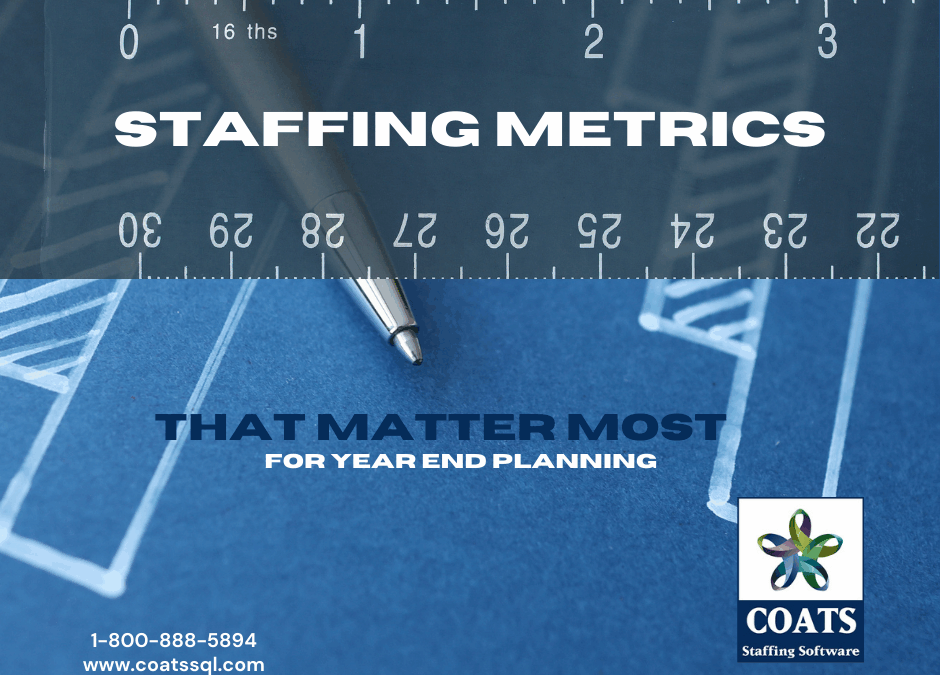Why Year-End Metrics Matter
During Q4, staffing firms face a critical opportunity: reviewing staffing performance metrics to measure results, identify trends, and set the stage for a stronger Q1. Year-end planning isn’t just about closing the books—it’s about using data to sharpen your strategy, improve recruiter productivity, and increase profitability.
That’s where COATS Staffing Software comes in. With built-in reporting and analytics, you can easily review the numbers that matter most before the year ends. For a deeper dive into how agencies have been applying these insights, see our post on staffing metrics.
The Core Staffing Performance Metrics You Can’t Afford to Miss
Fill Rate
How many job orders are being filled compared to those opened? Low fill rates may highlight sourcing gaps, skills mismatches, or inefficiencies in process. According to the American Staffing Association, client satisfaction often hinges on responsiveness—meaning agencies that consistently hit high fill rates are more likely to retain business.
In COATS: Analytics dashboards let you compare fill rates by recruiter, branch, or client, helping you identify patterns and adjust resources before the next quarter.
Time-to-Fill
Speed matters. A longer time-to-fill can frustrate clients, reduce revenue, and even cause lost opportunities. SHRM research shows average time-to-fill across industries is 36 days, but staffing firms are expected to do much better.
In COATS: You can break down time-to-fill by job type, recruiter, or client, uncovering where bottlenecks occur and creating faster pipelines.
Gross Margin & Profitability
Revenue tells you what’s coming in—but gross margin tells you what you actually keep. Year-end is the time to evaluate which clients, industries, or assignment types are most profitable.
In COATS: Financial reporting provides client-by-client profitability snapshots, so you can focus on your highest-value accounts and renegotiate with those that drain resources.
Recruiter Productivity
Tracking recruiter activity—interviews, submittals, placements—ensures accountability and highlights top performers. High productivity doesn’t always mean high profitability, but it’s a leading indicator of growth.
In COATS: Recruiter scorecards offer side-by-side comparisons of performance, which is powerful both for coaching and incentive programs.
Candidate Redeployment
Every time a great candidate finishes an assignment without a next step, your sourcing costs go up. Redeployment increases revenue while cutting expenses.
In COATS: You can set internal flags to identify “ready-to-work” candidates, reducing sourcing costs and filling new orders faster. Reviewing redeployment rates now can uncover revenue opportunities for Q1.
Bonus Metrics for Stronger Year-End Planning
Client Retention & Growth
Which clients are providing repeat business? Which are shrinking? Tracking retention rates lets you prioritize accounts for Q1 growth.
Talent Pool Growth
Your candidate database is a competitive advantage. Reviewing how much your database has grown—and how many candidates are active—can reveal gaps in sourcing strategy.
Job Order Mix
Are you seeing more temp, temp-to-hire, or direct hire roles? Understanding your job order mix helps you align with market trends and plan recruiter resources.
Turning Metrics into Action with COATS Analytics
The COATS Analytics Dashboard makes all these insights accessible at a glance. Instead of manually compiling reports, you can:
- Compare year-over-year performance trends
- Identify underperforming accounts or recruiters
- Spot industry or client-specific patterns
- Export polished reports for leadership or client meetings
Example: An agency using COATS discovered that while their gross revenue was up 12% year-over-year, one client was actually running at a negative gross margin. With this insight, they renegotiated rates and reassigned recruiters—protecting profitability going into Q1.
External Benchmarks to Strengthen Your Analysis
To put your staffing performance metrics into context, compare your results with industry benchmarks:
- ASA Economic Analysis – for staffing industry growth trends
- SHRM Talent Acquisition Benchmarking – for time-to-fill, cost-per-hire, and other recruiting KPIs
To compare your own staffing performance metrics against broader industry standards, consider external benchmarks—like those provided in the article on Top Metrics for Companies to Measure Staffing Performance. It includes industry‑relevant data on time-to-hire, fill rate, retention rate, candidate quality, and cost-per-hire.
By combining COATS’ real-time reporting with trusted external benchmarks, you’ll not only see how your firm is performing—you’ll know how you stack up in the wider staffing market.
Staffing success in 2026 won’t be about working harder—it will be about working smarter. The firms that review their metrics now will be better positioned to improve profitability, strengthen client relationships, and increase recruiter efficiency in the new year.
With COATS Staffing Software’s analytics and reporting tools, you don’t just track metrics—you turn them into action.
Want to see how COATS can help you measure and improve your staffing performance metrics? Schedule a demo today and start 2026 with clarity, confidence, and the right data at your fingertips.


